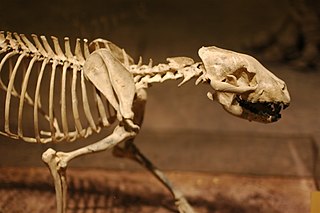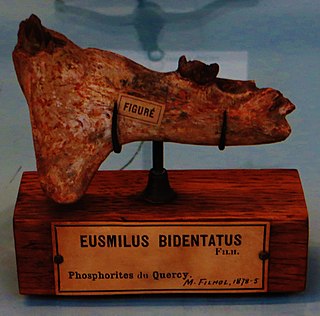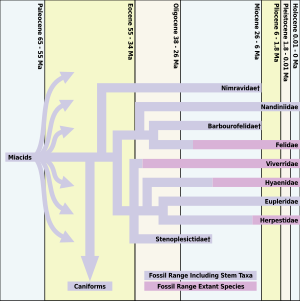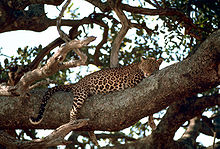
Carnivora is an order of placental mammals that have specialized in primarily eating flesh, whose members are formally referred to as carnivorans. The order Carnivora is the fifth largest order of mammals, comprising at least 279 species.

Canidae is a biological family of dog-like carnivorans, colloquially referred to as dogs, and constitutes a clade. A member of this family is also called a canid. The family includes three subfamilies: the extant Caninae and the extinct Borophaginae and Hesperocyoninae. The Caninae are known as canines, and include domestic dogs, wolves, coyotes, foxes, jackals and other extant and extinct species.

Felidae is the family of mammals in the order Carnivora colloquially referred to as cats. A member of this family is also called a felid. The term "cat" refers both to felids in general and specifically to the domestic cat.

Proailurus is an extinct felid genus that lived in Europe and Asia approximately 30.8-25 million years ago in the Late Oligocene and Miocene. Fossils have been found in Mongolia, Germany, and Spain.

Pseudaelurus is a prehistoric cat that lived in Europe, Asia and North America in the Miocene between approximately twenty and eight million years ago. It is considered to be a paraphyletic grade ancestral to living felines and pantherines as well as the extinct machairodonts (saber-tooths), and is a successor to Proailurus. It originated from Eurasia and was the first cat to reach North America, when it entered the continent at about 18.5 Ma ending a 'cat-gap' of 7 million years. The slender proportions of the animal, together with its short, viverrid-like legs, suggest that it may have been an agile climber of trees.

A saber-tooth is any member of various extinct groups of predatory therapsids, predominantly carnivoran mammals, that are characterized by long, curved saber-shaped canine teeth which protruded from the mouth when closed. Saber-toothed mammals have been found almost worldwide from the Eocene epoch to the end of the Pleistocene epoch 42 million years ago (mya) – 11,000 years ago (kya).

Caniformia is a suborder within the order Carnivora consisting of "dog-like" carnivorans. They include dogs, bears, raccoons, and mustelids. The Pinnipedia are also assigned to this group. The center of diversification for the Caniformia is North America and northern Eurasia. Caniformia stands in contrast to the other suborder of Carnivora, the Feliformia, the center of diversification of which was in Africa and southern Asia.

Nimravidae is an extinct family of carnivorans, sometimes known as false saber-toothed cats, whose fossils are found in North America and Eurasia. Not considered to belong to the true cats, the nimravids are generally considered closely related and classified as a distinct family in the suborder Feliformia. Fossils have been dated from the Middle Eocene through the Late Miocene epochs, spanning about 33.2 million years.

The extinct Borophaginae form one of three subfamilies found within the canid family. The other two canid subfamilies are the extinct Hesperocyoninae and extant Caninae. Borophaginae, called "bone-crushing dogs", were endemic to North America during the Oligocene to Pliocene and lived roughly 34—2.5 million years ago, existing for about 33.5 million years.

Dinictis is a genus of the Nimravidae, an extinct family of feliform mammalian carnivores, also known as "false saber-toothed cats". Assigned to the subfamily Nimravinae, Dinictis was endemic to North America from the Late Eocene to Early Miocene epochs, existing for about 16.8 million years.

Phlaocyon is an extinct genus of the Borophaginae subfamily of canids native to North America. It lives from the Early Oligocene to the Early Miocene epoch 33.3–16.3 Mya, existing for approximately 17.3 million years. It is closely related to Cynarctoides.

Eusmilus is a prehistoric genus of nimravid that lived in Europe during the Late Eocene to Early Oligocene epochs.

Barbourofelidae is an extinct family of carnivorans of the suborder Feliformia, sometimes known as false saber-toothed cats, that lived in North America, Eurasia and Africa during the Miocene epoch and existed for about 7.9 million years.

Feliformia is a suborder within the order Carnivora consisting of "cat-like" carnivorans, including cats, hyenas, mongooses, viverrids, and related taxa. Feliformia stands in contrast to the other suborder of Carnivora, Caniformia.

A hypercarnivore is an animal which has a diet that is more than 70% meat, either via active predation or by scavenging. The remaining non-meat diet may consist of non-animal foods such as fungi, fruits or other plant material. Some extant examples of hypercarnivorous animals include crocodilians, owls, shrikes, eagles, vultures, felids, most wild canids, dolphins, snakes, spiders, scorpions, mantises, marlins, groupers, piranhas and most sharks. Every species in the family Felidae, including the domesticated cat, is a hypercarnivore in its natural state. Additionally, this term is also used in paleobiology to describe taxa of animals which have an increased slicing component of their dentition relative to the grinding component. Hypercarnivores need not be apex predators. For example, salmon are exclusively carnivorous, yet they are prey at all stages of life for a variety of organisms.

Sansanosmilus is an extinct genus of carnivorous mammal of the family Barbourofelidae endemic to Europe, which lived during the Miocene, 13.6—11.1 mya, existing for approximately 2.5 million years.
Anictis is an extinct species of carnivorous cat-like mammal belonging to the superfamily Aeluroidea, endemic to Europe living from the Oligocene 33.9—28.4 Ma, existing for approximately 5.4 million years.

Stenoplesictis is an extinct genus of carnivorous cat-like mammals belonging to the superfamily Aeluroidea, from Europe and Asia (Mongolia), from the Oligocene 33.9—28.4 Ma, existing for about 5.5 million years.

Diegoaelurus is an extinct genus of placental mammals from extinct subfamily Machaeroidinae within extinct family Oxyaenidae. This genus currently contains only one species Diegoaelurus vanvalkenburghae, found in the Santiago Formation in California. This mammal lived during the Uintan stage of the Middle Eocene Epoch around 46.2 to 39.7 million years ago.

Pangurban is an extinct genus of the family Nimravidae, endemic to North America during the Eocene epoch. It contains a single species, Pangurban egiae. Occurring several million years before other named nimravids in North America, the discovery of this species suggests that hypercarnivores evolved and spread quickly after the warm middle Eocene.





















